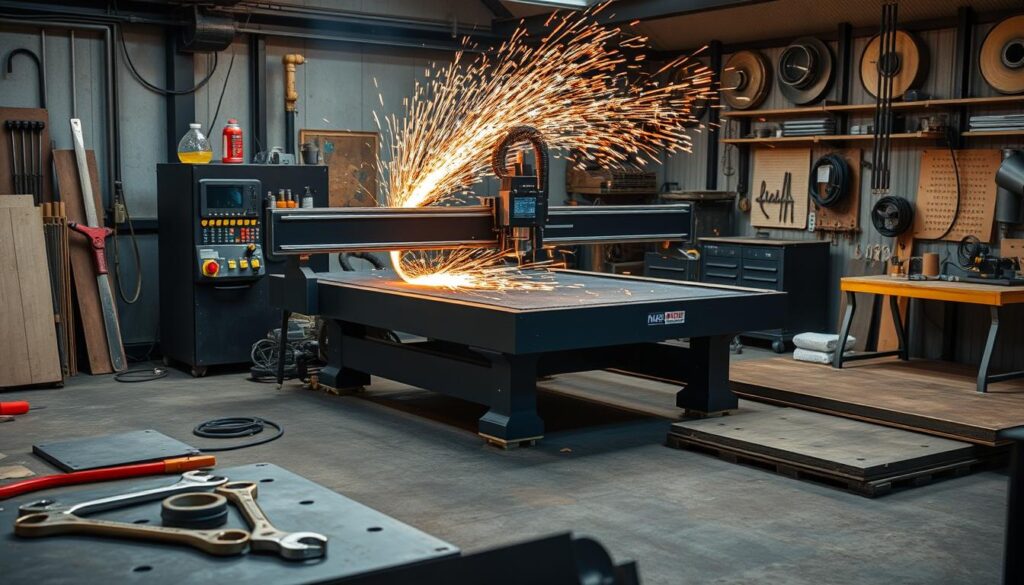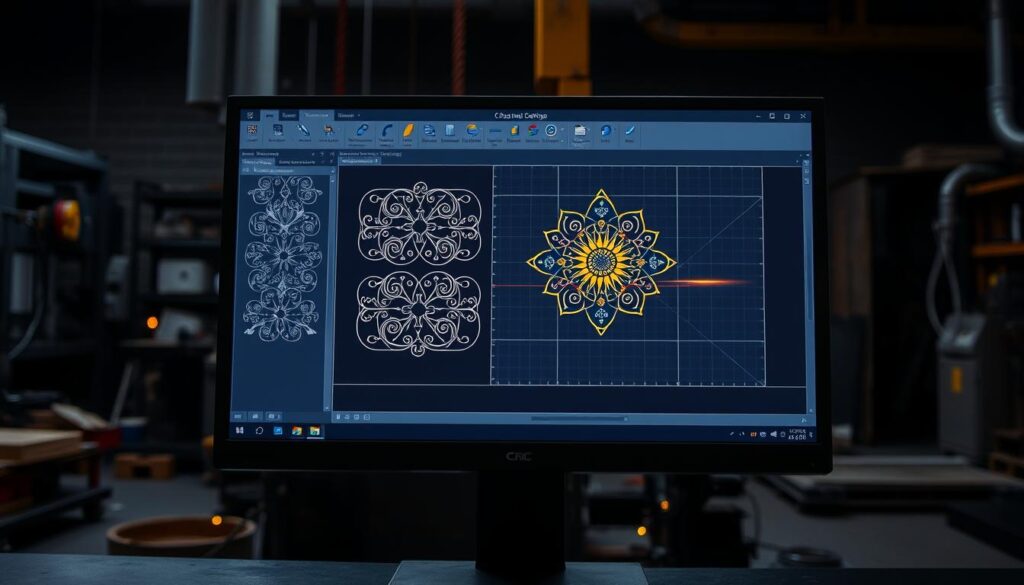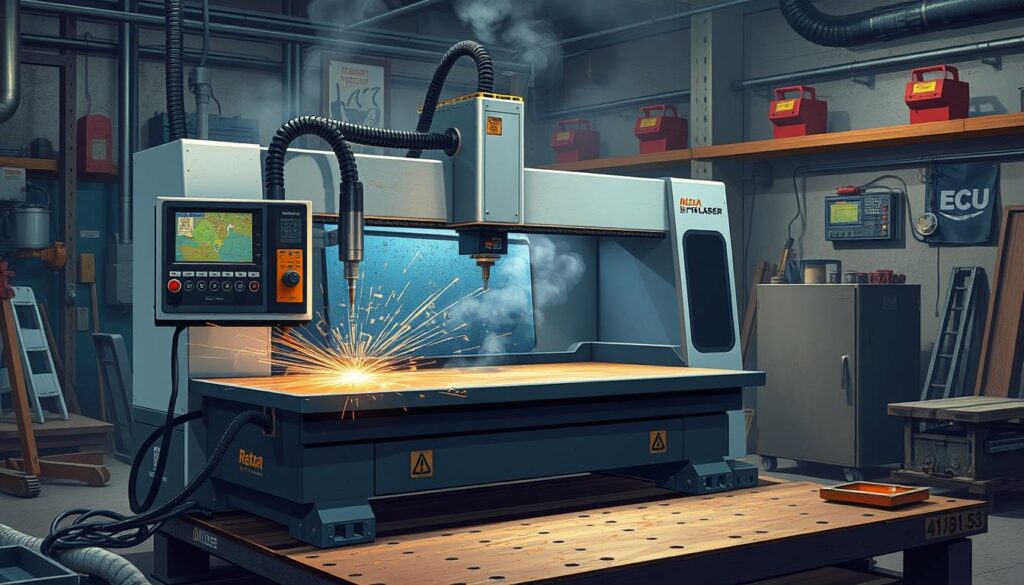-
 Звоните сейчас! +86-13912367818
Звоните сейчас! +86-13912367818 -
 Отправить по электронной почте сейчас info@wxhlhg.com
Отправить по электронной почте сейчас info@wxhlhg.com


Unlock the secrets to flawless CNC plasma cutting with our expert tips on avoiding common mistakes in precision metal fabrication. Keep your projects on track!
CNC plasma cutting boosts efficiency and quality in metal fabrication. But it's prone to errors like erratic movements and sensor issues. Some problems occur due to bad earthing or nearby electrical devices1.
To fix these, ensure good machine setup and keep it away from other devices1. Setting the right cutting parameters is key. Wrong settings can ruin quality and waste materials1. Also, keeping air pressure and power stable prevents issues and maintains quality1.
Choosing the right consumables, like nozzles and torches, affects performance1. Use parts that fit your machine to improve its life and efficiency.
Use trustworthy software to boost your workshop's output1. When your business grows, make sure your plasma cutter can handle new challenges and projects1.

● Implementing correct machine setup and proper earthing minimizes communication errors1.
● Utilizing precise cutting parameters prevents poor cut quality and conserves consumable life1.
● Regular inspection and maintenance significantly enhance CNC plasma machine efficiency2.
● Incorporating reliable software is crucial for optimizing workshop operations1.
● Choosing compatible consumables is essential for ensuring optimal machine performance and longevity1.
● Scaling equipment to business needs is vital for future growth and project capabilities1.
We know it's important to balance efficiency and quality in plasma cutting. Getting your CNC plasma cutting table to work best means setting the torch height and cutting speeds right. It also means keeping the power supply steady. Doing these things well ensures good cuts and that your equipment lasts longer.
Keeping the torch at the right height is key to avoiding damaging the torch and the workpiece. The best torch height keeps cuts accurate and reduces unwanted dross3. Adjusting the cutting speed is also crucial to cut down on dross and get a clean edge. The right speed, measured in inches per minute (IPM), makes a big difference in how well and fast you cut3.
Getting this balance right means there’s less clean-up work needed later. This saves time since there’s less grinding or touching up to do4.
A stable power supply is essential for smooth plasma cutting. It stops cuts from being slow or the machine from breaking down3. Your CNC plasma cutter should have a power supply that meets your machine's needs. This avoids partial cuts and sudden stops3.
Having enough power means better quality cuts. This results in more usable parts from each metal sheet, which saves on costs4.
But there’s more to it than just setting up your equipment. You need to keep doing regular checks and maintenance. Keep an eye on consumables like electrodes, tips, and nozzles3. They need checks to keep the cutting quality high. Also, make sure the air supply is clean and dry for accurate cuts and smooth operation.
Following these principles makes our plasma cutting strategy effective and efficient. It means every cut is done with precision. This way, every client gets only the best from us.
When picking a CNC plasma cutting machine, think about now and the future. A machine that seems big for your needs today might be just right as you grow. This is true for custom plasma cutting and industrial plasma cutting. Think about what materials you'll cut, their thickness, and how precise you need to be.
Plasma cutting has gotten better, making work easier and more productive. High-definition CNC systems can handle tough stuff like aluminum and stainless steel up to 2 inches thick5. Standard systems are good for steel up to 1 inch thick5. The material's thickness and type decide which plasma system you need.
New plasma systems are cheaper to run, thanks to better software and controls. They use less gas, and the parts last longer6. Smart software improves cut quality and helps manage materials more efficiently. This makes your shop run smoother and cuts down on wasted time6.
Duty cycle is a big deal, especially for high-volume work. Systems built for a 100 percent duty cycle keep going strong without losing quality. This is key to keeping up with work and meeting deadlines6.
| Gas Type | Material Suitability | Benefits |
| Compressed Air | Mild Steel, Stainless Steel, Aluminum | Cost-effective, versatile5 |
| Oxygen | Mild Steel | Enhances cutting speed, clean cuts5 |
| Nitrogen | High-Alloy Steel, Aluminum | Excellent quality, prevents oxidation5 |
| Argon-Hydrogen | Thick Stainless Steel, Aluminum | Faster cutting speeds, good cut quality5 |
| CO2 | Various Applications | Fast cutting speeds, increased consumable wear5 |
Choosing the right gas for your CNC plasma machine is crucial. It makes cutting efficient and precise. Picking carefully based on your work and goals makes a big difference. This is especially true for custom plasma cutting businesses looking to grow.

To effectively tackle communication errors in CNC plasma cutters, you should focus on hardware and software. Doing both improves how things work and boosts plasma cutting efficiency.
Good earthing and putting equipment in the right spots help reduce electrical issues. This means fewer communication errors. Using an earth stake, especially for machines like the XT table, is good. Following guidelines for earthing from the plasma source maker is key7..
About 70% of CNC plasma cutter issues come from bad grounding. This bad grounding can make the system arc and fail.
Choosing good software for CNC plasma cutting matters a lot. SURECONTROL is easy to use and accurate. It makes plasma cutting better. It's important to keep your software up to date. This prevents problems and makes the machine work better8.
| Issue | Percentage | Solution |
| System Arcing Due to Poor Grounding | 70% | Proper Earthing Techniques |
| Controller Power Loss | 45% | Check Stepper Amplifier Fans |
| Software Programming Errors | 25% | Regular Software Updates |
| Jerking Movements During Cutting | 25% | Correct G-Code Programming |
At Mekalite, we focus on these strategies to stop and fix communication issues in CNC plasma cutting. This way, our clients have fewer problems and get better results in their cutting projects.
It's crucial to keep CNC plasma cutting tables in top shape for the best performance. Proper maintenance doesn't just make the machine last longer. It also makes sure your cuts are always high quality and dependable.
Regular checks and upkeep are must-dos to keep your CNC plasma cutter working well. Setting up a maintenance plan can lower costs and stop small problems from getting big. This keeps your equipment running longer9.
Doing things like checking for wear and keeping parts clean and oiled means you can keep making things without pause9.
Many forget to adjust the cutting torch and power correctly for the material. Doing this right stops mistakes and damage to your projects10. Getting the cutting speed just right avoids rough edges and keeps cuts smooth10.
Keeping the torch and cutting area clean is key. It stops bad cuts and the quick wearing out of parts9.
| Maintenance Aspect | Importance | Frequency |
| Torch and Consumable Check | Critical for cut quality and precision | After every use |
| Cleaning Cutting Area | Prevents debris buildup and operational inconsistency | Daily |
| Electrical and Gas System Inspection | Essential for operational safety and reliability | Monthly |
| Software Calibration | Ensures accuracy in cutting based on programmed designs | Bi-Annually |
The success of CNC plasma cutting relies heavily on using the right consumables. The right CNC plasma cutter consumables are key for precision and the machine's longevity.
It's crucial to choose the correct CNC plasma nozzle and torch for various materials and thicknesses. Matching the amperage settings with nozzle specifications ensures efficient cutting and prevents wear11. Materials like copper and brass in nozzles focus the plasma jet effectively, enhancing cut quality11.
When consumables match system specs closely, many common problems are avoided12.
CNC torch maintenance includes frequent checks for the best performance and durability. The need to replace consumables, like all-copper electrodes at 0.040 in. hafnium pit depth, varies based on use12. Frequently changing electrodes, which wear down quickly, helps keep the machine in top shape. This should happen after a few work hours11.
It’s important to replace parts like ceramic shields on time for the best performance11.
Choosing the right CNC plasma cutter consumables and maintaining them well boosts efficiency and cut quality. By understanding each task's needs, picking the right consumables, and noting wear signs early, companies can save money and time. This also improves the accuracy of cuts.
In CNC plasma cutting services and metal fabrication, being precise is key. Yet, some common mistakes can mess up the work and the quality. Knowing these mistakes helps make things better and work smoother.
Issues often start with consumable parts wearing out in CNC plasma cutting services. These parts are crucial for good cuts. But when they go bad, it causes delays and drop in quality13. Heat can be a real problem, too. It happens when air can't move right in the nozzle, ruining the cut13.
Using a cutting tip for too long makes the center hole bigger. This makes the cut less neat, and it's harder to cut thick stuff13. Moisture in the air filter is another problem. It wears out parts faster and means you have to replace them sooner13.
Problems with CNC systems can slow things down. Fixing these fast helps keep money coming in13. Also, if there's not enough air pressure, the cuts won't be good. This can happen when there's not enough air getting through or if there's oil in the valve14.
Too much air pressure is bad, too. It spreads out the plasma arc's power, making cutting weaker. This is usually from wrong air settings or broken gear14. If cutting speeds are off or the torch isn't right, you get uneven cuts and too much slag14. These errors come from bad practices. Better training and checking equipment can fix them.
| Issue | Common Causes | Impact on Metal Fabrication |
| Prolonged consumable use | Extensive cutting tip use | Less clean cuts, difficulty with thick materials13 |
| Incorrect air pressure | Low input, blockages, faulty valves | Poor cut quality, weakened cutting strength14 |
| Moisture in air filter | Environmental factors | Increased wear on consumables, earlier part replacements13 |
| Inconsistent cutting speed | Improper settings, lack of training | Uneven cuts, increased slag14 |
So, fixing these common mistakes in metal fabrication leads to better CNC plasma cutting services. It means more shop profit and happier customers13. By dealing with cutting technique errors, we create a more productive and successful shop.

We are experts in CNC plasma cutting. We provide top-quality metal fabrication and manufacturing. Our technology works with all conductive materials. It handles various thicknesses. This helps many industries, like automotive and aerospace, benefit from our work1516.
Our CNC plasma systems can cut thick materials. They cut up to 160mm in aluminum and 30mm in stainless steel. This reduces labor costs. It also uses materials efficiently, thanks to our nesting software1516. Also, plasma cutting is faster and more efficient than other methods. It is great for medium-thickness materials. This ensures we keep our promise to protect material quality17.
We focus on innovation and safety. Our CNC plasma cutting tables remove fumes and allow hands-free operation. This makes our workplace safer16. These tables are precise and support creative work. They let designers explore new ideas. We lead in offering versatile project solutions. This includes both technical and artistic needs16. Our aim is to craft pieces that meet high standards and business needs151617.
Our goal is to excel in metal fabrication, following our Craftsman brand values. We provide great CNC plasma cutting services. We care about making our customers happy. By using data and feedback, we improve our work. We are confident in our skills. We meet the industry's changing needs with creativity and dedication151617.
Mistakes often happen, like wrong motor moves and sensor troubles. Wrong torch settings also cause problems. To fix these, set up the machine correctly. Follow the maker's advice on settings. Also, keep air and power right.
For better results, know the best torch height and speeds. Use a THC system and stick to the suggested settings. Make sure your power is strong and steady. This helps avoid tool issues and unfinished work.
Choosing the right tool means thinking of now and later. Pick a size that fits growth to not limit projects. Buy top-quality software and parts. This keeps your machine running well for longer.
To dodge communication mishaps, ground your setup well. Also, mind where you place other gear that might interfere. Choose CNC software that's easy and exact. A good setup means better cuts and less trouble.
Keep your table in tip-top shape by checking it often. Look for any wear or damage and fix it. Pay attention to consumables and clean the torch parts well. A regular care plan helps your gear last longer and work better.
The right consumables mean cleaner cuts and less machine wear. Match nozzles and torches with the material for best results. Change out worn parts on time. This avoids work stops and torch problems.
Errors often include wrong torch assembly and poor gas flow. Cutting speeds and pierce heights matter, too. Missing regular care lowers cutting sharpness and speed. Picking the right consumables and settings boosts quality.
Добавить комментарий